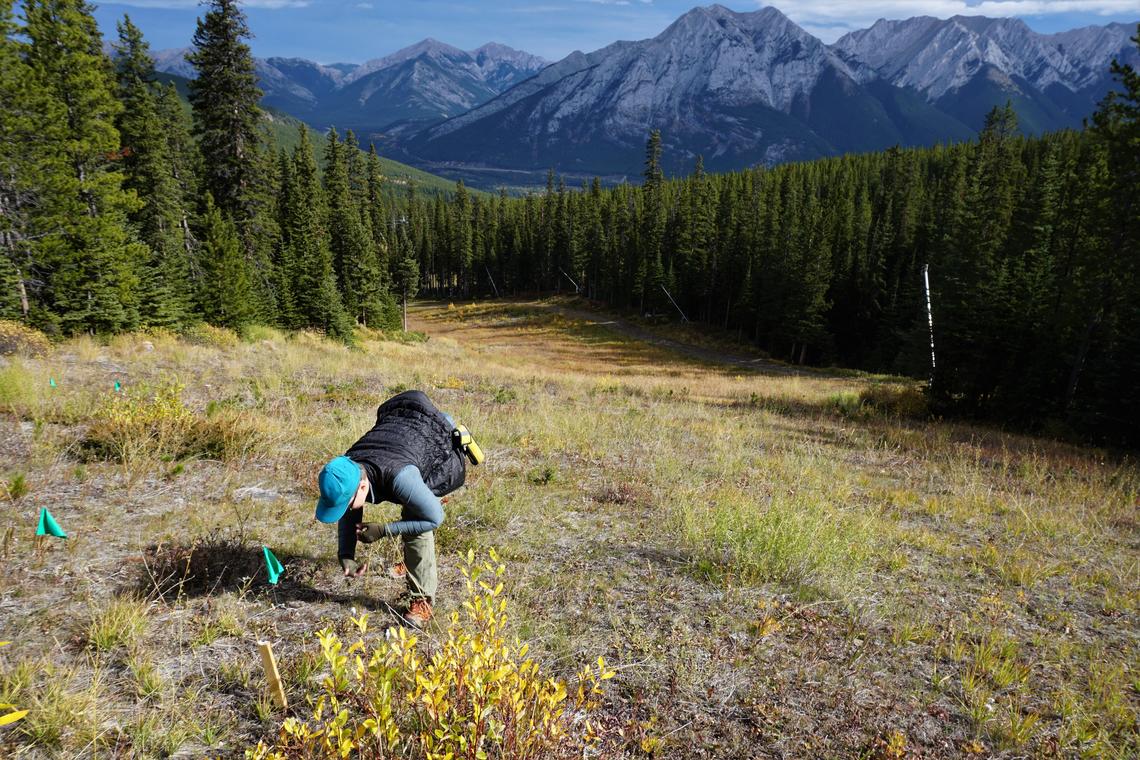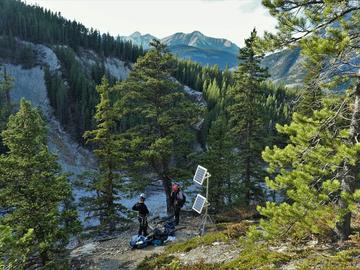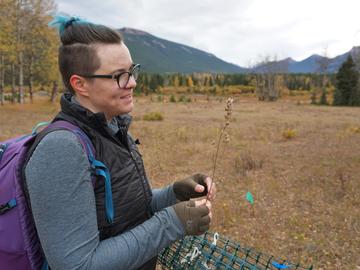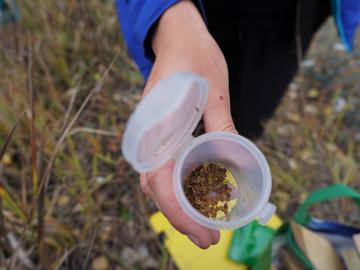Nov. 12, 2021
Notes from the field: Experience a day in the life of a researcher at reopened Barrier Lake Field Station

The Barrier Lake Field Station at the beloved Biogeoscience Institute in Kananaskis Country holds a special place in the hearts of many students, staff and alumni — not just from the University of Calgary but from schools across the country and around the world. The imposing Rocky Mountains, sprawling valleys, rugged cliffs and richly forested slopes form a memorable alpine backdrop for a variety of field schools, workshops, retreats, and research projects.
On pause for 18 months, the field station emerged from its pandemic hiatus to much excitement as visitors began safely returning this summer. Read on about the fieldwork by two groups of university students, one from UCalgary and the other from McGill University, who bring us along for a look as they scale hillsides and scan floral habitats, investigating biodiversity in K-Country.
Hanging with trees that thrive in rocky soils
First, let’s hang out with Estefania Roldan Nicolau, a PhD student, and Michelle Ives, a master’s student, both from UCalgary’s Faculty of Science. When we say hang out, we mean it literally: Many of their field sites are on cliffs!
Both researchers are interested in how trees access water in bedrock or other rocky soils. Their work involves scrambling or climbing to these locations to collect data. They use the data gathered from the locations and the trees to determine the amount and location of water within the rocks, a much less invasive method than blasting open the cliffs to locate the roots.
Nicolau’s work centres around building a model to help understand how trees regulate their water consumption in habitats with poor water access. She monitors sap flow while also collecting data on weather and precipitation events.
Learning from trees hundreds of years old
Many of the trees at her sites show signs of regulating long-term stress, such as reduced needle cover or a thinner layer of sapwood, the area of the wood where water and nutrients flow. Despite looking a little ragged with their small size and sparse needles, some trees clinging to cliffs are up to 400 years old.
Ives is also working on creating a model, but focuses on the water budget of cracks in the rocks. She hopes to gain insight into the geomorphology of the cracks by measuring surface water, the water used by the trees, and the water lost in surface runoff. She cores trees at each sample site to examine growth rings and get a sense of how growth may be affected by the structure and availability of water in the cracks. She believes the differences in the cracks could be responsible for variation in the growth rings of trees.
“You would think, looking at growth rings, you would see a peak in growth of all the trees in an area during a good year, but we are not seeing those consistent peaks with these trees,” says Ives.
As winter approaches, both women will spend their time in the lab and at home, analyzing their data and working with computer software to create their models, before returning for a final field season next year.

Meadley Dunphy examines equipment at a site on Nakiska ski hill.
Briana Van Den Bussche, Biogeoscience Institute
Frolicking in the flowers
Visiting from Dr. Anna Hargreaves’ lab at McGill University, Shannon Meadley Dunphy and Olivia Rahn spent their summer focusing on the flowers.
Not just any flowers, but the plant known as yellow rattle (Rhinanthus minor). Both researchers are interested in the plants’ native growing range at different elevations and under various conditions.
Rahn, a master’s student, is interested in habitat quality, especially abiotic factors or the non-living part of an ecosystem that shapes its environment. A current theory is that habitat quality declines as a plant nears its species limit. Testing this assumption, Rahn has plots across a range of sites where she looks at germination and seed production to measure lifetime fitness. The Rhinanthus minor is an ideal plant for this kind of study as it is one of few native annuals in the Rockies, which means lifetime fitness can be determined after just one growing season.
Another bonus of working with Rhianthus is that the seeds are relatively large and easy to handle compared to other plant species, making counting and planting less time-consuming. Rahn uses drone imaging techniques to gather mass spectral images which could help determine total biomass in her study areas.
Behold, the Rhinanthus minor
On the other hand, Meadley Dunphy, a PhD student at McGill, chooses sites where Rhianthus should do well based on the characteristics of the plant. As a root parasite, the plant needs to be close to other plants in order to steal nutrients and water. It still needs to photosynthesize, though, so it also requires sunlight. As a small, annual plant, it is a poor competitor against the nearby larger and more established perennials.
Meadley Dunphy’s fieldwork involved manipulating the habitat around Rhianthus to adjust its ability to access the roots of other plants as well as sunlight. She used cone-like structures she invented, which do not kill nearby plants, but push them out so they are not shading out the Rhianthus. She also designed special structures to enclose Rhianthus roots, allowing her to control how much they grew and accessed neighbouring plant roots.
Throughout the summer she recorded the growth of her plants, as well as nearby plants. This is the final year of Meadley Dunphy’s project, and she will now be analyzing her data in hopes of gaining a better understanding of the impact of sunlight and root access on Rhianthus in relation to its range distribution.
Rahn finished her field season by collecting Rhianthus seeds and replanting them in plots. She will return next summer to monitor their growth.
The Biogeoscience Institute and the Barrier Lake Field Station team thanks all the researchers and other visitors who joined us as we safely opened our doors again in 2021. Stay tuned for another Notes from the field, highlighting some animal-focused research.












